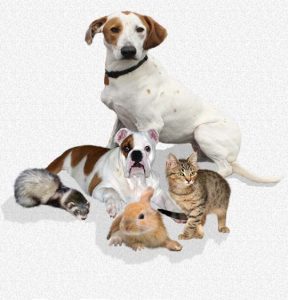Planning For A New Pet
Ron Hines DVM PhD
 How To Find Your Sweetheart Cat
How To Find Your Sweetheart Cat
Adding a new pet to your family is a joyous occasion that should leave lasting good memories. Try to make it a positive family experience by involving every family member, but it needs to be you, the adult, that makes final decisions. First, spend some time in introspection to guarantee that you are making the right decision. Do I have the time? Do I have the space? Can I afford its long-term care? I’m older now, have my needs changed?
Is This The Right Time?
Obtaining a new pet is a long-term commitment. Timing is very critical to success.
In about twenty percent of the situations I see, factors that motivated clients to obtain a new pet were not in the pet’s or the client’s long-term interest.
We often get pets soon after major life changes. The loss of a former pet, the loss of a spouse, a move to a new home, commitment to a new partner or a new children in the family are all common motivational factors. A common error is obtaining a new pet too soon after one of these events occur. How we adapt to the changes brought about by one of these events is unpredictable, so my advice is to wait six months after any major lifestyle change before deciding on a new pet. Once you decide that the time is right, make the decision process a thoughtful process. Selecting a pet should never be a spontaneous or spur-of-the-moment decision by a single family member. Although I know you mean well, pets are also something best not given to cheer up a depressed friend, your mom, your dad. If they want the companionship of a pet, it is a decision best left to them.
Is This the Right Pet For Me?
As important as timing is the choice of the right pet. Pocket pets like hamsters, rats and mice have a built-in advantage (or disadvantage) of a short life span.
Love between a pocket pet and its owner can be as profound as between a larger pet and its owner. This is more dependent on the owner’s ability to grant the pet desired attributes in the relationship than on the pet’s intelligence and innate traits. Pocket pets may be right for you if your life stays in flux or if little scurrying creatures appeal to your nature. They particularly tend to appeal to introspective owners.
Pocket pets are also a good first-time pets for children over the age of ten. But they need a thoughtful parent’s supervision. They encourage responsibility, stability and maturity. Pocket pets are also great for people with physical or emotional limitations. Dogs, cats, ferrets and rabbits require a longer commitment and, some would say, a deeper bond. Arguably, their ability to return affection and become family members is greater than that of pocket pets.
Dogs and cats are truly domesticated meaning that they have evolved to assume significant roles within the family unit – In the case of dogs, for at least 27,000 years. (read here) Dogs and cats are remarkable in that they can function as the prime relationship for single adult owners. Ferrets and rabbits also fill these roles for a smaller group of pet owners. The desire of dogs to please you can be greater than some human family members.
Spend time learning about the pet you are thinking of getting. The public library and the internet are good places to begin learning about your potential pet. There are books on the unique characteristics of each pocket pet as well as books on each breed of dogs and cats. The variation between the traits of dog breeds is enormous – greater than between species of animals. Some breeds are renown for their affection, others for their intelligence and yet others for their sensitivity. Once you have read up on the pet, get hands-on contact with the breed at events such as dog and cat shows. I suggest you do not buy pets from pet stores if you can possibly avoid it. They tend not to have your long-term interest or the pet’s interest in mind.
Adapting Your Home To Fit Your New Pet:
Domesticated pets have a great ability to adapt to new environments. However, it will be up to you to make some changes at home to accommodate your new pet. At least one family member will have to accept the new pet as their responsibility. This includes purchasing food and supplies, training the new pet and seeing to its emotional needs. Furniture within the house will need to be rearranged to pet-proof the house. Thermostats may need adjustment. The yard may have to be fenced, and delicate objects placed where they remain safe. Routines will need to be adjusted to meet the pet’s needs. If the pet is a new cat, dog, ferret or rabbit, food and water bowels as well as leashes, combs, collars, toys and bedding need to be purchased.
The Special Needs Of Young And Older Animals:
Obtaining a mature pet has several advantages. Because its mature personality is already established an older pet is a known commodity. Every pet has its own idiosyncrasies that are separate from breed and species. If the pet is mature, a short introductory period will tell you much about the pet’s temperament. Within a few days, barking, destructiveness, shy or gregarious nature and emotional demands become apparent in mature pets. Young pets tend to adjust to their new home situations more readily than older pets. However, they need more time-consuming guidance in adapting to the family’s needs. Housebreaking, leash training, curbing destructive behavior and dominance characteristics all must be molded in immature pets. You can read about the special needs of older dogs here and here and elderly cats here.
Bringing Your New Pet Home:
Kittens and puppies ferrets and rabbits are best obtained when they are about eight weeks of age. By this time, they are quite independent, and their individual personalities can be judged. Just like people, some animals are extroverts and others more withdrawn and introverted. Choose an individual animal that has characteristics that approximate your own personality. The particular species you choose imparts basic traits – but individual pet personality is independent of species.
To determine the pet’s individual personality, sit quietly in the home that is selling or providing the animal. Is this an outgoing youngster that comes to greet newcomers and shows intense interest is its surroundings or is it more reserve and stand-offish? Is it a gregarious clown or a more stoic and reserved companion? Certain puppies and kittens are more fearful of new situations than others. These traits tend to remain for the life of the pet. Some animals welcome change and new experiences while others withdraw from these situations.
Training Your Pet To Be An Integrated Family Member:
All domestic animals want to please their owners. Domestication has given them a desire for human companionship. With this desire comes a need to enter the family unit and interact in the social structure in which it is immersed. There are many outcomes to integration and the pet relies on you to indicate how you want the relationship to progress. If you are assertive with the pet it will usually become submissive to you. If you are submissive to the pet it will usually assume an assertive role. Most traits that we identify as bad behavior in pets are attempts by the pet to adjust to a role for which the pet is unsuited.
Common Pitfalls:
A common source of stress is differing expectations of the pet from different family members. It is hard for the pet to please if different family members want different things from it. If children rough-house with a puppy – it will assume it should do that with everyone in the family.
Pets have a tendency to become closest to a single family member. This can be a source of concern. Pets rely on unspoken cues that indicate the family role that is desired of it. Pets do best when they are not above any human family members in the family’s social hierarchy.
Once their level in family peck order is established it becomes very difficult to change. Pets do not do well in leadership roles within the family. They are more comfortable when owners lead and define the boundaries of the relationship. Allowing the least dominant family member to feed and care for the pet helps in giving that member a dominant position. It is also important that family members be uniform in their expectations from the pet. For example, if one member enjoys a barking, vocal dog and another does not the pet will be uncertain whether to bark or not.
Bonding With Your New Pet:
Young immature pets bond might more rapidly to you than mature adult dogs and cats. Particularly when they were rescue dogs or cat that had a difficult life before you gave them a second chance. Try to obtain your new pet when you have several months of uninterrupted time to spend with it. During that time, make the pet the focus of your activity. Do not obtain pets when stressful events are looming on the horizon. Even mature pets develop strong bonds to new owners. Pets key off of your level of interest in them. If the pet is only a small part of your life then the pet is likely to reciprocate in its lack of affection for you.
Introducing Your New Pet To The Other Family Pets:
When you make a new pets the center of your activities do not neglect showing affection to your other pets. New pets must find their place among other pets, and they will seek your guidance in forming these relationships.
Give the pets that have been with you longer verbal praise and pet and stroke them lavishly when they interact with the new pet in the way you desire. Jealousy is a very strong emotion in pets, so try to distribute your affection diplomatically. Remember that it may not be the newest pet needs praise the most.
Your New Pet In The Extended Family:
Introduce your new pet to your parents and friends in a formal way. Let these other people in your lives stroke and feed your new pet a treat or two. This helps establish a positive relationship. The introduction of a new pet is a good time to mend fences and improve relationships of your own. Pets quickly sense tensions within the extended family. Don’t bring your pets to visit your friends unless you know the visit is appreciated. Like your children, let your pets know they need to be on especially good behavior during visits.
Reinforcing That Bond:
Like all relationships, the bond between you and your pet will suffer if it is neglected. Pets are very forgiving in their relationships – more so than human beings. It takes no more than a kind word a pat or a stroke to bring happiness to our pets. Reserve an hour a day during which you make the pet the center of your activities. Bring them presents, celebrate their birthdays, and special occasions just as you do for your other family members. Their happiness at these occasions will mirror your own.
You are on the Vetspace animal health website
Visiting the products that you see displayed on this website help pay the cost of keeping these articles on the Internet.

